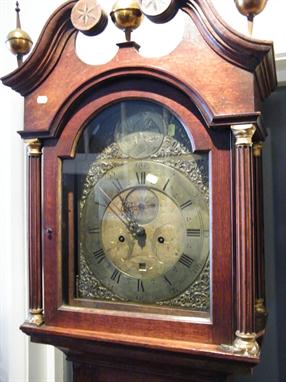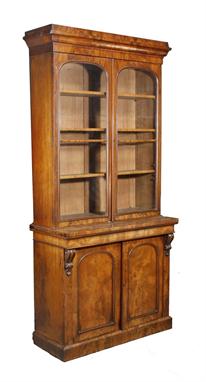We found 42009 price guide item(s) matching your search
There are 42009 lots that match your search criteria. Subscribe now to get instant access to the full price guide service.
Click here to subscribe- List
- Grid
-
42009 item(s)/page
Six Mauchline ware items, book trough with loch scene decorated arch-top end panels, 35cm long, card case "Melrose Abbey and Abbotsford" 8cm long, rustic napkin ring "Faneuil Hall, Boston", Miniature treen bowl, "Princes Street, Edinburgh", 7½cm diameter, Inimitable strap (razor strop), 17cm long, and Bell with long turned handle, "Burns Cottage" (no clapper), 17cm high (6)
A micro mosaic circular panel, 19th century, depicting The Forum, Rome and mounted in a square gilt gesso frame, roundel 24.5cm diameter, frame, 43.5cm square. The Forum depicts the Arch of Septimuis severus, the three surviving Corinthian columns of the Temple of Vesparsian built in A.D.81 by Domitiane and to its right the Temple of Saturn, also the solitary column of Foca and in the distance the Colosseum and the arch of Titus.
*Bleriot Anniversary Race. Daily Mail Bleriot Anniversary Race, 1959, London-Paris Special Award, commemorative engraved pictorial gilt silver plaque in slightly curved shape with rounded corners, featuring Marble Arch and the Arc de Triomphe, mounted on a wooden base with metal label engraved `Won by the BEAline Syndicate of thirteen competitors for their outstanding example of initiative and ingenuity`, 9 x 15 x 6cm, together with a commemorative RAF farewell wooden shield for Air Commodore Charles Maughan from Bonn Air Attache Club for his time served 1970-1972, painted logo and scroll in relief with gilt name plaque beneath, 19 x 16cm. Air Vice-Marshal Charles Maughan CB CBE AFC 1923-2009. Maughan was the commanding officer of No. 65 Squadron based at Duxford when the Daily Mail announced its sponsored `Arch to Arc` air race to commemorative Bleriot`s cross-Channel feat of 1909. Maughan`s remarkable winning time was 40 minutes and 44 seconds for which he was presented with a cheque for £6,500 and a trophy received from Lord Rothermere. On 22nd July, starting at Marble Arch on an RAF motorcycle, Maughan rode to Chelsea Reach where a Sycamore helicopter was waiting to take him to Biggin Hill. There he jumped into a two-seater Hunter and flew to Villacoublay, followed by another helicopter ride to Issy, and a final motorcycle dash to the Arc de Triomphe. (2)
A 19th Century oak and mahogany longcase clock by W. Williams of Llannadock, the 13ins arched painted dial with country scenes to arch and corners and with calendar aperture to the thirty hour movement striking on a bell, contained in case with scrolled cresting, with turned pillars to hood and trunk, on splayed front legs, 88ins high (extensively faded to case and worn to dial)
An early 19th Century oak longcase clock by James Last of Stalham (Norfolk), the 12ins arched painted dial with Roman numerals and subsidiary seconds dial and date aperture, the arch and spandrels decorated with shells to the eight day two train movement striking on a bell, contained in plain oak case with shaped cresting and turned and fluted pillars to hood, arched trunk door, 82ins high (case reduced in height and dial in need of cleaning), complete with pendulum, two cast iron weights, crank winding handle and door key Note : James Last record working Stalham 1796 and there is also recorded a clockmaker of the same name working 1836 (possibly father and son). The painted dial is by Walker & Hughes, Birmingham, who were in partnership from 1811 to 1835, and thus the clock will date circa 1820
A late 18th/early 19th Century mahogany longcase clock by Robert Woollan of Glastonbury, the 12ins arched brass dial with wide silvered chapter ring with Roman and Arabic numerals and date aperture, the arch showing phases of the moon, and with silvered name plaque to the border to the eight day two train movement striking on a bell, contained in mahogany case inlaid with figured panels, crossbanding and ovoid shell motif, the upper part with moulded scroll pediment and turned and fluted columns with Corinthian capitols to hood and with conforming quarter columns to trunk, 85ins high
An early 19th Century mahogany longcase clock by C. Heizman of Canterbury, the 12ins arched painted dial with Roman numerals and subsidiary seconds dial and with painted romantic landscape to arch, to the eight day two train movement striking on a bell, contained in plain mahogany case with arched and moulded cornice and plain turned pillars to hood, arched trunk door and on bracket feet, 80ins high Note: Charles Heitzman recorded working Canterbury 1832-1847
Rare MKI Pattern British Crimean War Military SaddleThis is a wood-arch officer’s saddle for the RHA and Artillery, although probably also used by some cavalry officers, even though the latter had the Hussar officer’s saddle. The cantle section of the wood is stamped London, but the maker`s name immediately above is illegible. The wood-arch officer’s saddle and Hussar saddle were both used over the same time period - from pre-1864 to 1903. The Hussar pattern was in use during the Crimea War. The MKI in official use up to 1889. The MKII to 1899. The MKIII from 1899 to 1903. This is an example of a MKI saddle, of an earlier rather than later manufacture.The wood-arch officer’s is often thought to be a UP1856 saddle, but the wood arch officer’s saddles have brass trim to the rear arch, and eight rivets attaching the seat to the rear arch. This example has eight rivets. The UP1856 has no brass trim to the rear wood arch and only 6 rivets attaching the seat. The tightening straps have eight holes on each side of the saddle and are numbered 1 through 8 on each side, but naturally the numbers on the near side are more worn. Both brass stirrups are stamped US.It is well documented that the CSA purchased these saddles from England and by good fortune they made their way through the blockade. The saddle was in use from the mid-1860s through 1889, so it could well be one that was sold to, and imported by, the Confederacy. Condition: Excellent.Starting Price: $300
A French Louis XV style gilt brass mounted ‘boulle’ bracket clock, Charles Taylor & Son, Paris, circa 1870, the circular eight-day bell striking movement signed Cha’s, Taylor, Paris to backplate, the twelve-piece white Roman numeral cartouche dial with foliate cast decoration to centre and pierced blued steel hands, the waisted case with standing putto surmount to the cavetto shaped upstand with foliate corner mounts, rococo scroll crest anove the shaped tied foliate bud decorated front door surround incorporating figural decoration to apron, the sides with recessed shallow arch windows and the surfaces inlaid in brass with foliate designs on a mottled red shell ground, on scroll cast feet with apron between, 42cm high; with a modern wall bracket with similar faux shell and brass marquetry decoration and cast brass mounts, 58cm high overall
A French gilt brass carriage clock, unsigned, early 20th century, the eight-day gong striking movement with silvered platform lever escapement and engine turned rectangular dial with Arabic numeral chapter ring and blued steel hands, the case with hinged carrying handle above shallow arch bevel-glazed front and side windows and acanthus cast fluted column uprights to angles, on skirt base applied with foliate mount to front and simulated squab feet, 14.5cm high excluding handle
A Victorian rosewood mercury stick barometer, Negretti and Zambra, London, late 19th century, the arched ivory vernier scale calibrated in barometric inches and with the usual observations opposing a Fahrenheit scale alcohol thermometer beneath signature NEGRETTI & ZAMBRA, LOMDON to arch, the slender trunk with exposed tube above domed cistern cover and level adjustment screw to the shield-shaped base, 91cm high
An oak cased ‘Admiral Fitzroy’s’ barometer, Davis and Company, late 19th century, with syphon tube applied over paper double scale calibrated in barometris inches and with the usual observations beneath incsription DAVIS AND COMPANY ‘Fitzroy’s Prize Medal Barometer’ the lower section with instructions for interpreting observations above storm tube opposing alcohol Fahrenheit scale thermometer, the arch top case with Gothic revival style foliate finial and gilt brass Royal Warrant crest beneath glass above twin level recording screws to the uprights and on short skirt base, 119cm high
A George III mahogany cased eight day longcase clock with arched brass dial, the arch inscribed `John Barr, Port Glasgow`, the dial with silvered chapter ring, engraved decoration, date aperture, subsidiary seconds dial, twin winding holes and applied brass spandrels, with twin weights and pendulum, height 228cm (7ft 6in) (illustrated)
A late Georgian mahogany banded oak cased eight day longcase clock, the painted arched dial with moonphase to the arch and inscribed `Holmes, London`, with twin weights and pendulum, trunk door applied with old trade label to the reverse for `H Wollen 137 Granby Street, Liverpool`, height 230cm (7ft 6in) (illustrated)
-
42009 item(s)/page


























































